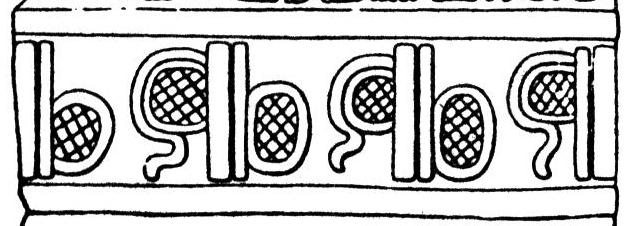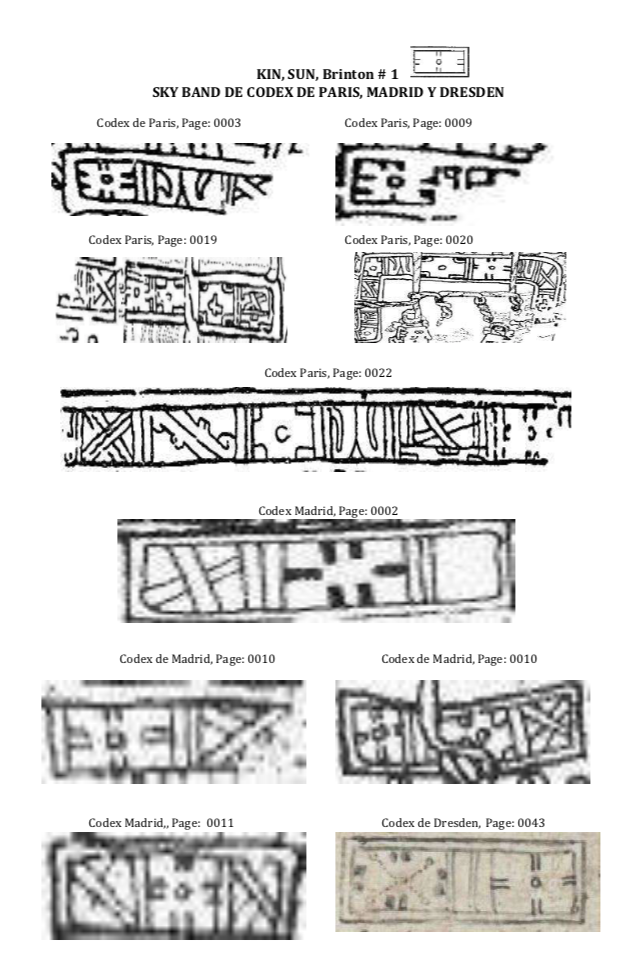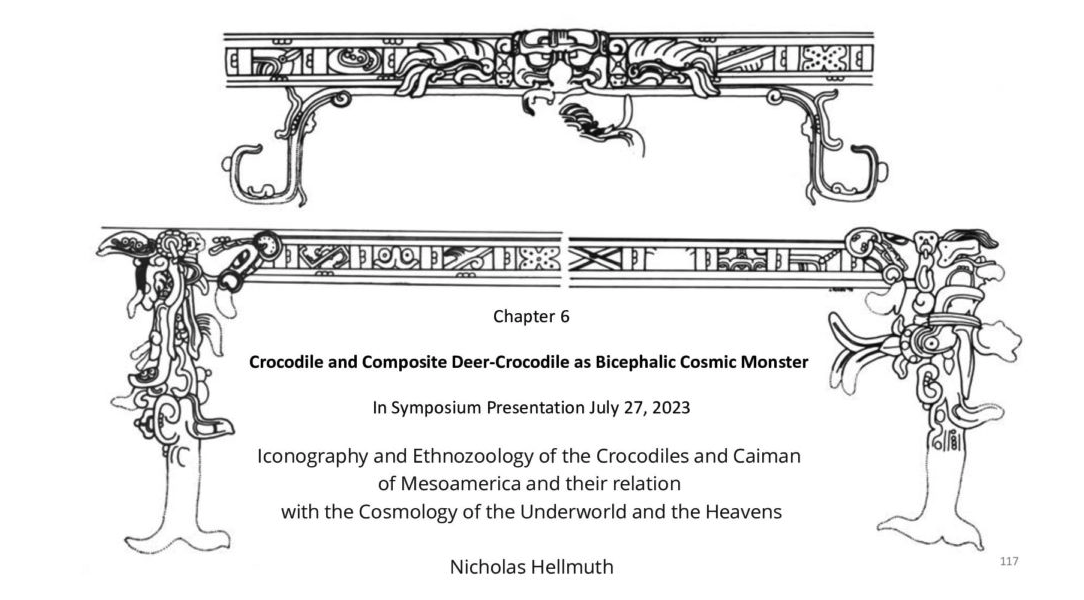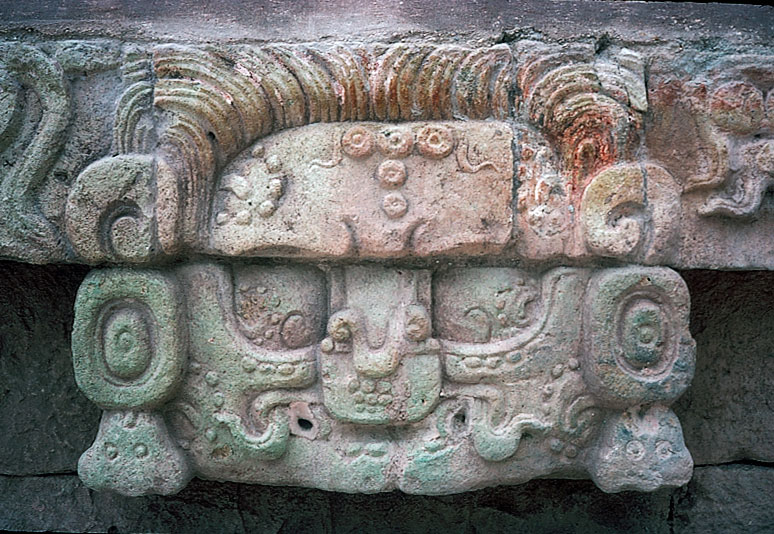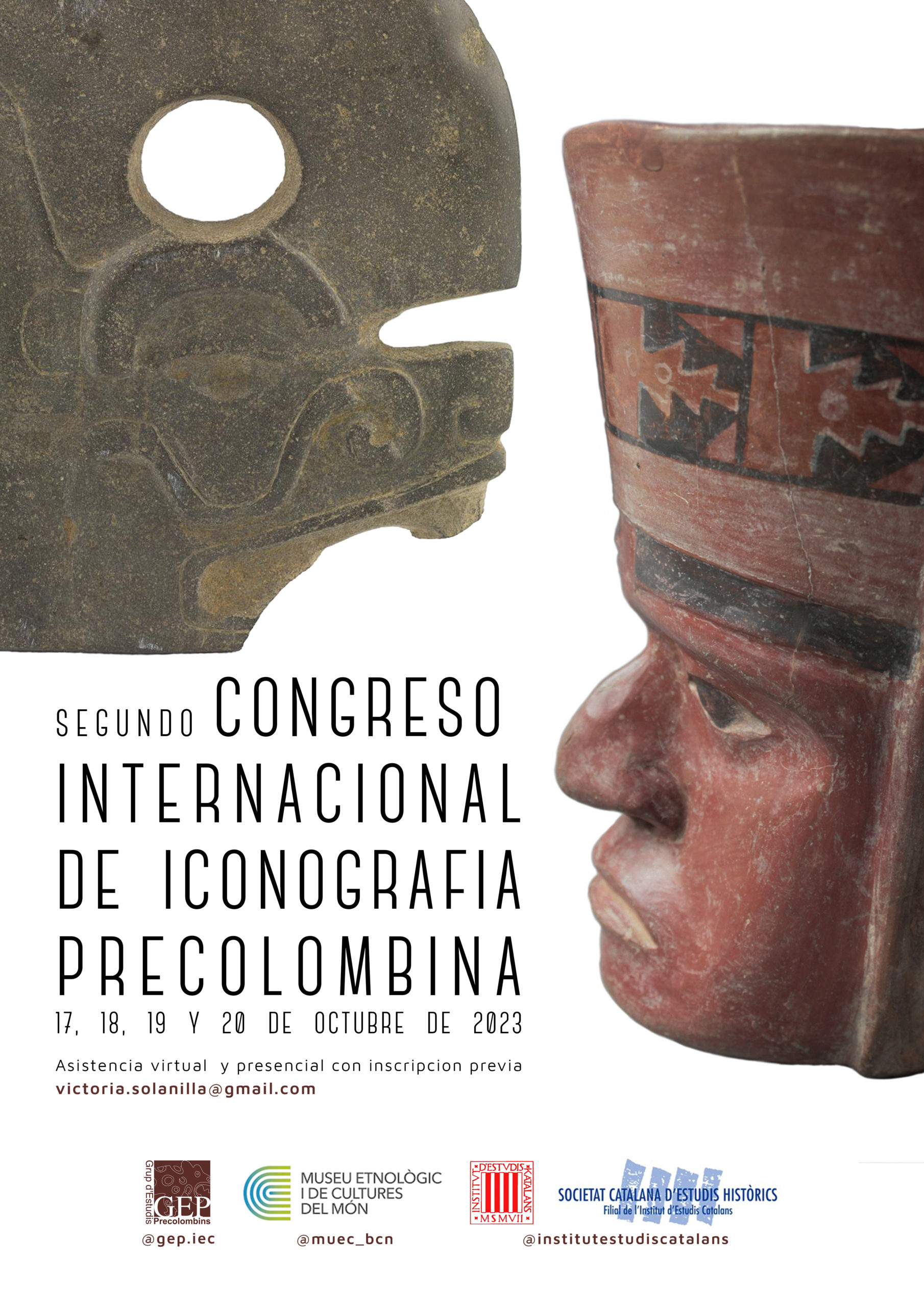Lecture on Iconography of Sky Bands, Earth Bands, Skull & Crossed-Bones Bands in Classic Maya Art
The Sky Band (also spelled as one word, Skyband) is the best-known horizontal band of motifs each framed in a rectangular frame. Most are flat (horizontal) but they can often be stepped or as steps up to throne room or as roof of throne room (as perch for the Principal Bird Deity). The motifs of Sky Bands are celestial: stars, planets, moon and other Maya concepts of the sky. There are lots of books and dozens of articles by archaeo-astronomers, epigraphers and archaeologists on Sky Bands, but we have found Sky Bands never previously published.
 |
This is a Sky Band that is previously unpublished as a line drawing so you can study each feature. Illustrator Luis Molina is producing drawings for the CIIP23 presentation by Nicholas Hellmuth. |
I jumped deep into Sky Bands in August 2022 and with the FLAAR Mesoamerica team we prepared tabulations, lists, inventories of more Sky Bands than are already known (since we found lots on unpublished plates and vases).
While cataloging and classifying the different kinds of bands of celestial motifs, due to the large size of the available corpus, I obviously noticed the other bands of motifs starting with the Earth Band. Then I found that the Witz Monster (Cauac Monster) could occasionally be a horizontal band. Since the Sky Band is so well known, the October lecture by Nicholas Hellmuth for CIIP23, in Barcelona, Spain, will be on all the other bands that are not as well known.
To learn more about Maya archaeology, excavations, stratigraphy, site mapping, artifact analysis are all important. This is what I did as a student intern at Tikal for 12 continuous months in 1965. Then I focused on mapping Yaxha for many years in the 1970’s. But since there are so many capable Maya archaeologists accomplishing archaeology out in the field, I have focused on iconography, the study of symbolism. I also am dedicated to cosmology, the study of symbolism of the world around us: below (the Surface of the Underwaterworld), the Earth Band of Caban scrolling designs, the rock-solid cave filled mountains (Witz Band), and the celestial motifs above us, the Sky Band.
The Earth Band
The Earth Band is well known from sculpture of Palenque, Chiapas, Mexico. But when you have a comprehensive database of drawings of stelae, then you can find Earth Bands on many other stelae. I sincerely thank the many colleagues who have sent me their drawings and shared their databases. This is one reason that already I have started to make available photos from the FLAAR Photo Archive (of Classic Maya art) to make our material available in appreciation.
So far I have gathered together from months of research, one of the large epigraphic and iconographic list of Earth Bands. I will show key examples in the lecture in October. You can attend remotely from anywhere and everywhere in the world (check the CIIP23 web page and social media pages).
To study Maya archaeology it helps to have a huge library, especially an e-library
Sky Band Above, Earth Band Below
We all know the expression, the sky above the earth below. For the Maya it was often the Sky Band Above and the Earth Band Below. But often it was the Surface of the Underwaterworld below and often it was the Witz Mountain below the Sky Band with the Surface of the Underwaterworld flowing out of the karst mountain.
Thirteen Levels above and Nine Levels below is from the Chilam Balam of Chumayel. The Ceiba tree as the multiple levels above is Aztec-Mixtec and is not as well documented by the Classic Maya. Ceiba spines are shown in cache vessels, burial urns and incensarios, but we (FLAAR) have found lots of other trees native to Mesoamerica that have identical conical spines and are not related to the Ceiba genus nor it’s family. For example, the Crocodile Tree is often a Crescentia species, a calabash tree (mentioned in completely different context in the Popol Vuh and clearly pictured in Preclassic and Classic Maya art.
Thirteen Levels Above and Nine Levels Below
So I have not yet found 13 Levels Above and Nine Levels Below, because the Vase of 11 Gods are most likely of Xibalba rather than the heavens (and don’t have the presumed 13 patron gods). 13 Levels Above and 9 Levels below is from Post Classic times. If a scene shows 13 gods (instead of 7 or 11) and if these are celestial deities instead of demons, devils and deities of the Xibalba underworld, then I would accept 13 layers of heaven. 90% of the web pages and articles that mention the 13 and 9 layers (and the ceiba tree as the center) are copy-and-paste. This cosmology needs iconographic, epigraphic, and linguistic evidence for the Classic Maya (not the Aztec and their neighbors).
The Vase of Seven Gods is pretty much same scene as Vase of the Eleven Gods (God L is presiding inside a cosmological throne room constructed of Cauac Monster Witz stone as lower area and stone back wall.
I highly recommend learning about the cosmology of the Maya from the Popol Vuh and even better from scenes on vases, bowls, plates and bas-relief sculptures.
The Maya “World” as Three Levels
That there are three layers of the Maya world (heaven, earth, underworld), is the concept in 90% of the web pages and popular articles that have not fallen into the 13 Heavens and 9 Underworld crevice. Heavens are pictured everywhere: Sky Bands, Cosmic Monster (often incorporating the Sky Band but not always).
Earth is pictured as the Earth Band. But what about the Witz Mountain of the Cauac Monster? This rises above the earth? And, if there are caves within the Witz, that is access to the Surface of the Underwaterworld. So why not four levels.
And, is the Water Lily Underwaterworld area a layer separate from the Surface layer (the Surface of the Underwaterworld). So why not four levels?
- Sky Above (Cosmic Monster, Sky Band, etc.)
- Witz Level, Cauac Monster symbols
- Earth Band, Caban symbols
- Surface of the Underwaterworld
But where do the Skeletal Demons of Xibalba live? Other than skulls generating water lily plants in the Surface of the Underwaterworld, what cosmological symbols show the cosmological position of the Skeletal Demons, Devils and Deities of Xibalba?
I dip into these concepts and confusions in my mid-October lecture in CIIP23, in Barcelona, Spain. Will be in Spanish but all illustrations can be understood in any language and I can answer questions in English and a bit auf Deutsch.
Multiple Underworld “Houses of Xibalba”
Cave of Jaguars, Cave of Pus, Cave of Scorpions and other segments, “houses” of the underworld of Xibalba, are well documented in the book of the Popol Vuh. I have explored caves throughout Guatemala and some remote cenotes in Mexico. A quarter century ago I found the River of Pus entering a cave at the bottom of a cenote. Was amazing. Unfortunately we have not yet rescued any photos of this adventure.
I have hiked into the Cave of Scorpions (in Alta Verapaz) and was bleeding up and down my legs within minutes. We have entered the Cueva del Tigre inland from Livingston (tiger is local word for jaguar in most of Mesoamerica). Jaguars like to enter caves so several caves throughout Mesoamerica have this logo-name.
Although the October 2023 lecture is on visual painted, incised or carved bands of motifs, I enjoy keeping track of the areas within Xibalba. But how many are visually pictured in scenes or mentioned in hieroglyphic inscriptions? For example, scorpions are present in Maya art, but rare (I have had more scorpions in my presence more often them in Maya art and colleagues have had them in their shoes and others have mentioned they had tarantulas in their beds).
Sky Bands associated with the bicephalic Cosmic Monster
The band of celestial motifs that forms the body of many bicephalic Cosmic Monsters is well known. But if you dedicate months of in-depth iconographic research, you begin to notice regional and temporal variation. But since the Sky Band and Cosmic Monster are already well known, I will just show and mention a few in the October lecture. I prefer to jump into less-well-known cosmological bands plus introduce several that may not previously have been mentioned or discussed.
To request this lecture for your museum, or if a professor wants it in their classroom, contact FLAAR MESOAMERICA symbol FLAAR.org (replace the word with the actual symbol and close the space and you can write and ask for Dr Hellmuth to come to your location anywhere in the world, or present the lecture via ZOOM. |
While on the subject of patolli game boards, FLAAR has an entire PowerPoint presentation available on patolli game boards of the Maya, Teotihuacan, Tula. The sacred Popol Vuh book of the Maya describes the family of the Hero Twins playing patolli. When Nicholas was 19 years old, he discovered a patolli game board incised on top of a rectangular plastered bench at the south end of a Late Classic palace facing the East Plaza. The corner of this palace was less than 3 meters from adjacent northeast corner of the grand pyramid of Temple I. |
The Cauac Monster and the Witz Monster, occasionally as a Horizontal Band
When the scene with a bunch of grape sized grapes is on a head of a Maya monster, iconographers call this the Cauac Monster; epigraphers usually call it the Witz (stone mountain) Monster. Lots of Maya symbols have multiple names: God N is known as Pauahtun and God N and as Bacab (depending on what year they are writing and what their focus us.
When stone and mountain is the intended meaning, then Witz Monster is appropriate.
There are LOTS more rows of motifs in Maya art besides just Sky Bands, Earth Bands, Witz Bands, etc.
Decorative Bands in Classic Maya Art
The lecture presentation will remind us of Decorative Bands, meaning repeated motifs. These probably had more meaning a thousand years ago than merely decoration.
Symbolic Late Classic Maya “Bands of Continuous Motifs” that have not been studied before?
The Hellmuth presentation at the October CIIP23 event will present several bands common on Tepeu 1 polychrome pottery that we estimate may never have been focused on before. We will show digital rollouts, which means rollouts by Hellmuth with digital rollout system that he had decades ago. Many of these rollouts have not previously been published. Plus, since these rollouts are digital, their resolution and image quality is noticeably high quality (since these are not from old scanned medium format film; these are direct from a tri-linear scan back of Better Light). Hellmuth and FLAAR were beta testers for their first generation Dicomed version of Better Light and then based on our feedback the rollout camera got more software plus the next generation Better Light rollout camera. We could use the in-camera software to measure the rollout so there was less distortion. Rollouts with a motorized camera, with old-fashioned medium-format film, were reportedly done with a tabulation, to estimate rollout speed based on experience. But many vases, bowls, and plates are not perfectly round; and many ceramics do not fit the tabulation. You can see the distortion in many “motorized” rollouts (when the film moves too fast or too slow the hieroglyphs and figures are scrunched or pulled too wide).
So a lot to see and learn about at the CIIP23 presentation.
Why does a Maya archaeologist study “Bands”?
My PhD dissertation focused on the symbols, water biology (fish, water lilies) that showed what I named the Surface of the Underwaterworld. These scenes tended to be horizontal bands, or when on the lids of cylindrical tripods, continuous bands in the round shape of the lid. So most of these symbols were arranged in bands, often layered (with various symbols in each layer. You can see all this in the 1986 dissertation, published in 1987 in English as Surface of the Underwaterworld and separately auf Deutsch, MONSTER und MENSCHEN in der Maya-Kunst). About 727 illustrations (photos, maps, drawings) in the German edition (captions are in English and introduction is in English).
Then in August 2022 I jumped up into Sky Bands. Again, horizontal bands, albeit sometimes stepped and sometimes as horizontal pillars to hold up a roof of a “Sky Band Throne Room” of a ruler or deity.
So during month after month of library research and on-line research on celestial bands, I began to notice other bands. First the Earth Band (of Caban hieroglyphs and affixes). Then I noticed that the Cauac symbols occasionally formed a band. Plus I found the obvious skull band of Uxmal.
Gradually I found other bands that I had, in the previous half-century of iconography research (1965 while at Tikal for 12 months, onward) not previously studied. I began noticing other bands. So I realized that just as I did an entire PhD dissertation on Underwaterworld Bands, if I could show colleagues lots of other bands, this would provide material for students to tackle these with MA thesis (for one or two different kinds of bands) or as a PhD dissertation (for all bands together).
And I estimate that for a PhD dissertation that students will find bands that I have not yet cataloged. Also epigraphers and iconographers will find other bands, plus improve my nomenclature (since each scholar has their own database and their own experience).
First posted October 6, 2023 by Nicholas Hellmuth

